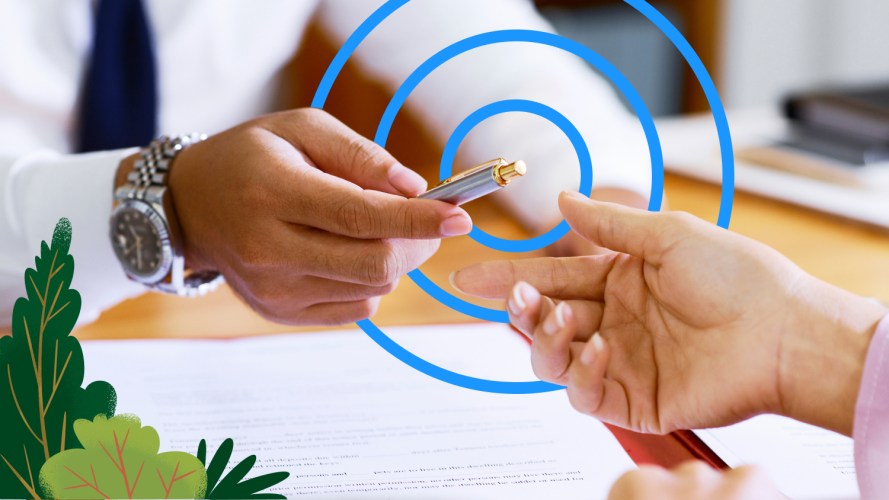Ever watched improv comedy? If you find a comic with a sense of humor that meshes with your own, it’s hilarious. It’s also impressive — not many people can stand up in front of a crowd and riff while also being clever and funny.
That’s what a job interview feels like sometimes. How do you answer challenging questions on the spot while being witty and engaging? For salespeople, there’s no better example of this than the “sell me this pen” interview question. If you’ve never experienced it before, it’s a simple conceit: The interviewer pulls a pen out of their pocket and asks you — the job candidate — to make up a sales pitch on the spot.
Where do you even begin? How do you hit on the right points while holding the interviewer’s attention? I’ve got some tips that might help.
What you’ll learn:
Join the Salesblazer movement
We’re building the largest and most successful community of sales professionals, so you can learn, connect, and grow.

Why interviewers want you to sell them a pen
To overcome your dread of this challenge, it can be helpful to understand the purpose behind it. Interviewers may ask you to sell them a pen, or another object in the room, for several reasons. They’re typically looking to see:
- How you react to the unexpected
- Whether you can adjust to unforeseen challenges
- If you can keep your cool under pressure
- Whether you can think on the spot
These are all things that salespeople have to do on the job every day, so it makes sense that an interviewer would want to assess your skillset by throwing you an actual selling question.
I have a similar approach when interviewing candidates, though I do give them some prep time. Before the interview, I ask them to prepare to sell me one of the products or services we offer. Sometimes I’ll even ask them to record themselves selling it. This shows me what they deem important to research and how they approach the sales process.
Of course, springing this challenge on a candidate has its uses, too. For example, someone who isn’t easily fazed and can adapt on a whim can be a great asset in sales. But you can only suss that out if you ask them to “sell me this pen” without forewarning.
If you encounter the “sell me this pen” challenge, consider it an opportunity to show that you can adapt to the needs of the moment.
(Back to top)
5 key elements of a good answer to “sell me this pen”
A good response to the pen challenge mirrors a persuasive sales pitch. But persuasive pitches aren’t the same as pushy. They start with understanding your customer. If you want to prepare for the “sell me this pen” question, here are some things to consider:
- Identify your customer‘s needs, pain points, and “why.” Starting a sales conversation with questions will show that you understand what sales are all about — finding solutions — which you can’t do without a clear understanding of your customer. This “pre-work” will separate you from someone who isn’t as attuned to the concept. More on this in a later section, where we’ll dive into specific questions you can ask to learn more.
- Confirm that you understand. Knowing why the interviewer needs the pen, how they’ll use it, and how a pen can help them achieve what they want is key to selling. Getting confirmation also gives you a chance to make sure you heard them correctly the first time and clear up anything you didn’t understand.
- Show how your pen can solve their problems. Our State of Sales research shows that value-based communication — solving buyer problems over leading with product pitches — is a top technique in deepening customer relationships. So, try to frame the pen as a solution to your interviewer’s wants and needs. Does it provide extra comfort for people who have to sign dozens of documents every day? Is it made from premium materials, increasing its value? Is it refillable, making it better for the environment? Whatever’s important to your interviewer, tailor your pitch to that.
- Create urgency and desire. The best sales pros go deep to uncover a customer’s most pressing need and then create urgency by demonstrating how their offering can fulfill it. So try to frame the pen as vital to your interviewer’s need in an honest way. Get them excited about how it will accomplish their goals and improve their lives at the same time.
- Close the sale quickly and naturally. As they begin to show interest in the pen, see if they agree that it meets their needs. As naturally as possible, ask if they’d like to purchase the pen.
Bottom line: Focus on the customer, not the pen. Tailor the pen to what you discover about the customer.
How do you know if you passed the “Sell me this pen” test? The person across from you seems genuinely eager to buy it. You’ve successfully transformed a pen into a solution to one of their most pressing problems, and they’re excited to act.
(Back to top)
Questions to ask when responding to “sell me this pen”
Keep in mind that this exercise isn’t all about selling a pen. It’s also about evaluating if a prospect is the right fit for your offering — also known as lead qualification — and demonstrating to your interviewer that you understand this process as well. To take it a step further, try to create a sense of urgency around your offer. Ask questions about the interviewer’s pen preferences, goals, and frustrations.
Try these questions to get the conversation going:
- How often do you use pens? This lets you know how much your prospect relies on your product or service. Do they use it consistently? Every day? Multiple times a day? If so, this is likely an important decision for your customer. If it’s not something they rely on every day, they may not have as much immediacy when it comes to making a purchase decision.
- How do your current pens perform? This helps you understand the status quo. It lets you know what’s currently working and what could be improved. You should pay attention to both and tailor your solution in a way that builds on what’s working and addresses what’s lacking.
- What do you like best about pens you’ve used in the past? This question helps you better understand your customer’s preferences. You can use this information to highlight similar features or outcomes of your offering. Plus, it gives you a chance to show how your offering can help them achieve their targets.
- What has bothered you about other pens you’ve used? This is a good question to understand your customer’s pain points and challenges with similar products. Use this information to differentiate from your competitors, stand out, and solve their problems.
- What are all the ways you use pens? This one helps you learn more about your prospect’s needs and use cases. Asking this can give you insight into specific features that are important to them and what they value most.
- Do pens serve any other purposes for you? Ask this to uncover other things that are important to your prospect. For example, they may be looking for a pen because they need to write. But they probably also want one that’s easy to use, writes smoothly, and saves them time. This is an opportunity to highlight secondary benefits of your offering such as productivity, efficiency, or security.
- Are there any other people who will be using your pen? If so, should we talk with them, too? This is a good question to learn if other people should be involved in the decision-making process. If so, you’ll want to pull them into the conversation as soon as possible to have a better chance of winning the deal.
- Does this exact pen meet your needs? After you’ve presented your offering, this is an opportunity for your prospect to let you know why or why not they believe it’s a good fit for them. If they have objections, this is a chance to present them with additional information, like case studies and success stories, if you truly believe they could benefit from your solution.
If your pen doesn’t meet their specific needs, consider suggesting a different model with features that may align better. But know that you won’t win every prospect. If you can’t meet someone’s needs or realize they won’t be a good customer, don’t qualify them. This helps you keep focused on your most promising leads rather than on leads that probably won’t convert.
(Back to top)

Thanks, you’re subscribed!

Tips for responding to this challenge
Successfully navigating this challenge demonstrates not only your confidence but also your ability to be present in the moment and address needs quickly. If you’re wondering how you pass the pen-selling test, remember that there’s not one correct answer. Here are some tips for approaching the challenge:
- Remember that it’s not about the pen. Dig deeper to learn about your customer’s needs and wants. Asking questions that get to the root of common issues — “Why do you use pens?” “What challenges have you had with pens in the past?” “Do you have a favorite pen?” “What do you love about it?” — can reveal more about their pain points, goals, and desires. You can then use those insights to guide your pitch.
- Consider the benefits. Without immediately talking up the pen, you need to bring it into the conversation at some point. Consider all the reasons someone may need a pen and why they’d choose one over another, then address any pain points they currently face, including leaks, breaks, or running out of ink too fast. You might opt to highlight durability, functionality, appearance, color, quality, materials, or a combo. Just remember to align the benefits with what your customer — in this case, the interviewer — says is important to them.
- Be authentic. Don’t approach the conversation with a script in mind. Try to strike a balance between delivering what’s expected and pitching off the cuff. Your unique spin on answering this question will help you stand out from other candidates. Actively listen to the interviewer’s responses to your questions and adjust your approach in the moment. Remember that they care less about the actual sale of a pen and more about how you react under pressure.
- Have fun with it. It’s okay to show your personality. A sense of humor can go a long way in sales, so take time to build rapport. During one sales pitch in my career, I quickly realized that I was wearing mismatched earrings. Not a big deal, but I decided to call it out and own it. My client and I laughed and both felt more relaxed moving forward. When you’re open and comfortable, the person on the other side of the table will be, too.
(Back to top)
From selling pens to mastering sales
While the “sell me this pen” challenge can feel intimidating, there’s a reason many sales candidates are asked to sell something during their job interview: It shows off their natural sales ability. To make sure you make the best impression, ask guiding questions to gather more information and react in the moment. As you adjust to the interviewer’s personality and listen to their needs, you can shake your nerves, demonstrate your sales ability, and make a good first impression.
Want to take the #1 CRM for a test drive?
Go on our Guided Tour to see how Sales Cloud boosts productivity at every stage of the sales cycle.













